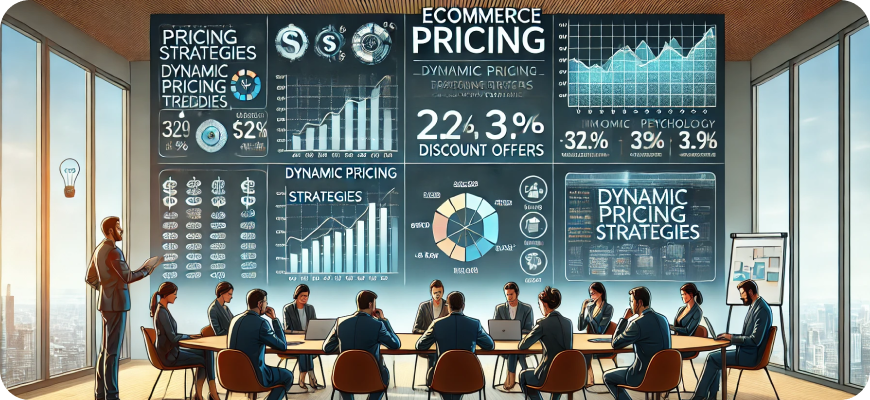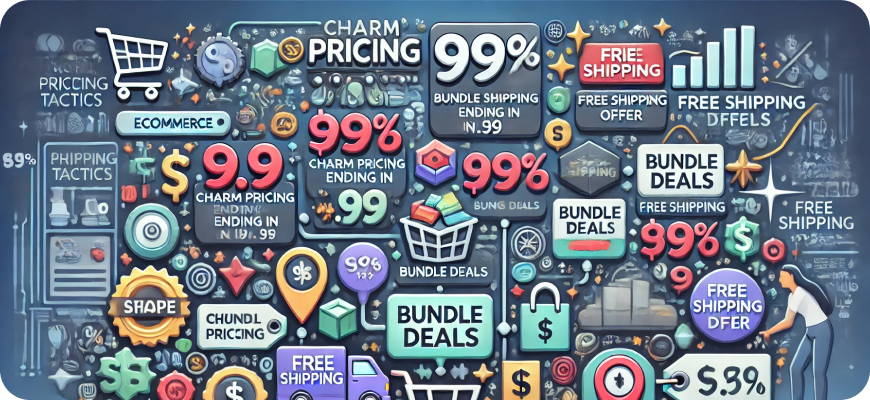Ecommerce Pricing Tactics and the Psychology Behind It
In the world of ecommerce, pricing is far more than just a number attached to a product. It’s a strategic tool that businesses use to influence consumer behavior, create perceptions of value, and ultimately drive sales. Understanding the psychology behind how people perceive prices and making the most of proven pricing tactics can spell the difference between a successful sale and a missed opportunity. In this article, we’ll explore the intricacies of ecommerce pricing tactics and delve into the psychological principles that make them effective.

The Role of Price Perception in Ecommerce
- Psychological Pricing Psychological pricing involves setting prices in a way that affects a customer’s perception of a product’s cost. One of the most widely recognized examples of psychological pricing is “charm pricing,” where prices are set to end in .99 or .95. For example, a product priced at $9.99 appears cheaper to customers than one priced at $10.00, even though the difference is only one cent. This happens because customers tend to focus on the leftmost digit of the price, making $9.99 feel closer to $9 than $10.
- The Power of Context and Anchoring Price anchoring is another powerful tactic that leverages human psychology. It involves presenting a higher-priced item first to make subsequent items appear more affordable. For example, if an ecommerce store shows a luxury item priced at $500 next to a similar product priced at $200, customers are more likely to perceive the $200 item as a bargain due to the anchoring effect.
- Price Framing How a price is presented or “framed” can significantly influence buying behavior. For instance, offering a product at a “50% discount” is likely to generate more sales than simply stating the new price, even if the final amount remains the same. Highlighting savings and limited-time offers creates a sense of urgency and emphasizes the perceived value.
Key Ecommerce Pricing Tactics
- Discount Pricing and Sales Promotions Discounting is one of the most straightforward ways to entice customers to make a purchase. Sales promotions, limited-time offers, and seasonal discounts create urgency and a fear of missing out (FOMO), which can lead to impulse purchases. To maximize the psychological impact of discounts, it’s important to clearly display the original price alongside the sale price, emphasizing the savings.
- Bundle Pricing Offering product bundles—several items packaged together at a reduced price—encourages customers to spend more by giving the impression of added value. For example, an online store selling skincare products may offer a discounted bundle that includes a cleanser, moisturizer, and serum. Customers perceive a higher value in purchasing the bundle versus buying each product individually.
- Free Shipping Thresholds Free shipping has become a key factor in the ecommerce decision-making process. Many online retailers set a minimum order amount that qualifies customers for free shipping, such as “Free shipping on orders over $50.” This encourages customers to add more items to their cart to meet the threshold, ultimately increasing the average order value (AOV).
- Tiered Pricing Tiered pricing offers customers multiple pricing levels for different product tiers or features. For instance, a software company may offer “Basic,” “Pro,” and “Enterprise” pricing plans, each with increasing functionality and benefits. This tactic appeals to a wide range of customers by providing options and catering to varying budgets. Additionally, placing the middle-tier option in the spotlight often encourages customers to select it, as they perceive it as offering the best balance of features and value.
- Price Matching Guarantees Price matching is a tactic used to reduce potential customer hesitation by offering to match a competitor’s lower price. This helps build trust and reassures shoppers that they are getting the best deal available. The psychology behind this tactic is rooted in reducing perceived risk and enhancing customer confidence in the brand.
- Dynamic Pricing Dynamic pricing involves adjusting prices based on market demand, competitor pricing, and customer behavior. This tactic is commonly used in industries like travel and hospitality but has gained traction in ecommerce as well. Online retailers use algorithms and data analytics to change prices in real-time, capitalizing on peak demand periods and optimizing revenue.
- Loss Leader Pricing Loss leader pricing involves selling a product at a loss or at a very low margin to attract customers to the store. The goal is to encourage shoppers to make additional purchases at regular prices. For example, an ecommerce store may offer a popular item at a significant discount, drawing in customers who are then likely to explore other products.
- Pay What You Want (PWYW) PWYW pricing allows customers to choose their price, often within a suggested range. This approach relies on the psychology of reciprocity, as many customers will pay a fair or even generous price because they appreciate the flexibility and trust placed in them. While not suitable for all products, it can be effective in specific niches, such as digital products or charitable offerings.
The Psychology Behind Ecommerce Pricing Strategies
- Scarcity and Urgency Scarcity and urgency are powerful psychological drivers that push customers to take immediate action. Scarcity creates the perception that a product is in limited supply, increasing its perceived value. For example, showing “only 3 items left in stock” can make customers act quickly to avoid missing out. Urgency, on the other hand, leverages time-based constraints, such as “Sale ends in 24 hours,” to prompt immediate purchasing decisions.
- Social Proof and Price Social proof can influence how customers perceive prices. Reviews, testimonials, and user-generated content can validate the value of a product, even if it is priced higher than competitors. Seeing other customers endorse a product makes shoppers feel more confident in their purchase decision, reducing the perceived risk.
- Decoy Effect The decoy effect occurs when an additional pricing option makes one of the original options more appealing. For example, if an ecommerce store offers a small coffee for $2.50, a medium coffee for $3.00, and a large coffee for $3.50, customers are more likely to choose the large option because the medium option serves as a decoy, making the large seem like better value.
- Price-Quality Heuristic The price-quality heuristic suggests that consumers often associate higher prices with higher quality. This is why luxury brands are able to command premium prices. In ecommerce, setting a higher price can create a perception of superior quality, while offering discounts or promotions strategically can help capture price-sensitive shoppers.
- Anchoring Bias As discussed earlier, anchoring is a cognitive bias where individuals rely heavily on the first piece of information they see when making decisions. Ecommerce retailers use this by displaying a high original price alongside a discounted price, creating the impression of a good deal and making the lower price seem more attractive.
- Odd-Even Pricing Odd-even pricing, also known as charm pricing, is a tactic that relies on pricing items just below a round number (e.g., $9.99 instead of $10.00). The psychological impact comes from the perception that prices ending in .99 are significantly cheaper than their rounded counterparts, even if the actual difference is minimal.
- Price Sensitivity and Elasticity Different customers exhibit varying levels of price sensitivity. By segmenting customers and understanding their price elasticity, ecommerce stores can optimize their pricing strategies. For example, price-sensitive customers may respond more strongly to promotions and discounts, while premium customers may value exclusivity and superior quality over low prices.
- Gamification of Pricing Gamifying the shopping experience through pricing promotions can create excitement and engagement. Techniques like spin-to-win discounts, flash sales, and loyalty rewards transform the act of shopping into a game, making customers more willing to explore and purchase products.
Leveraging Technology for Pricing Optimization
Ecommerce businesses can maximize the effectiveness of their pricing strategies by using technology-driven solutions. Pricing automation tools, A/B testing, customer segmentation software, and advanced analytics platforms all provide valuable data and insights. These technologies allow businesses to continuously fine-tune their pricing strategies based on real-time market conditions, customer behavior, and competitive intelligence.
Real-World Examples of Ecommerce Pricing Strategies
- Amazon’s Dynamic Pricing Amazon leverages dynamic pricing to offer competitive rates, adjusting product prices multiple times per day based on demand, competitor prices, and other factors. This real-time approach ensures Amazon stays competitive while optimizing revenue and profit margins.
- Apple’s Premium Pricing Strategy Apple positions its products as high-end, using a premium pricing strategy to create a perception of exclusivity and superior quality. Despite their higher price points, Apple products attract loyal customers who view them as status symbols and are willing to pay more.
- Warby Parker’s Bundle Deals Warby Parker, an online eyewear retailer, uses bundle pricing by offering discounts on the purchase of multiple pairs of glasses. This encourages customers to spend more while perceiving added value from their purchase.
- Booking.com’s Scarcity Tactics Booking.com employs scarcity and urgency messaging to great effect, such as “Only 1 room left at this price” or “10 people are currently viewing this room.” These tactics push customers to book quickly due to fear of missing out.

Conclusion
Ecommerce pricing strategies are far from one-size-fits-all. By understanding the psychology behind how customers perceive prices and leveraging proven tactics such as discounts, dynamic pricing, bundling, and price anchoring, businesses can effectively influence purchasing decisions and boost sales. Combining psychological insights with advanced technology and data analytics enables ecommerce businesses to optimize their pricing strategies and remain competitive in a constantly evolving market. Ultimately, successful pricing strategies are about finding the delicate balance between customer perceptions of value and the business’s goals for profitability and growth.






